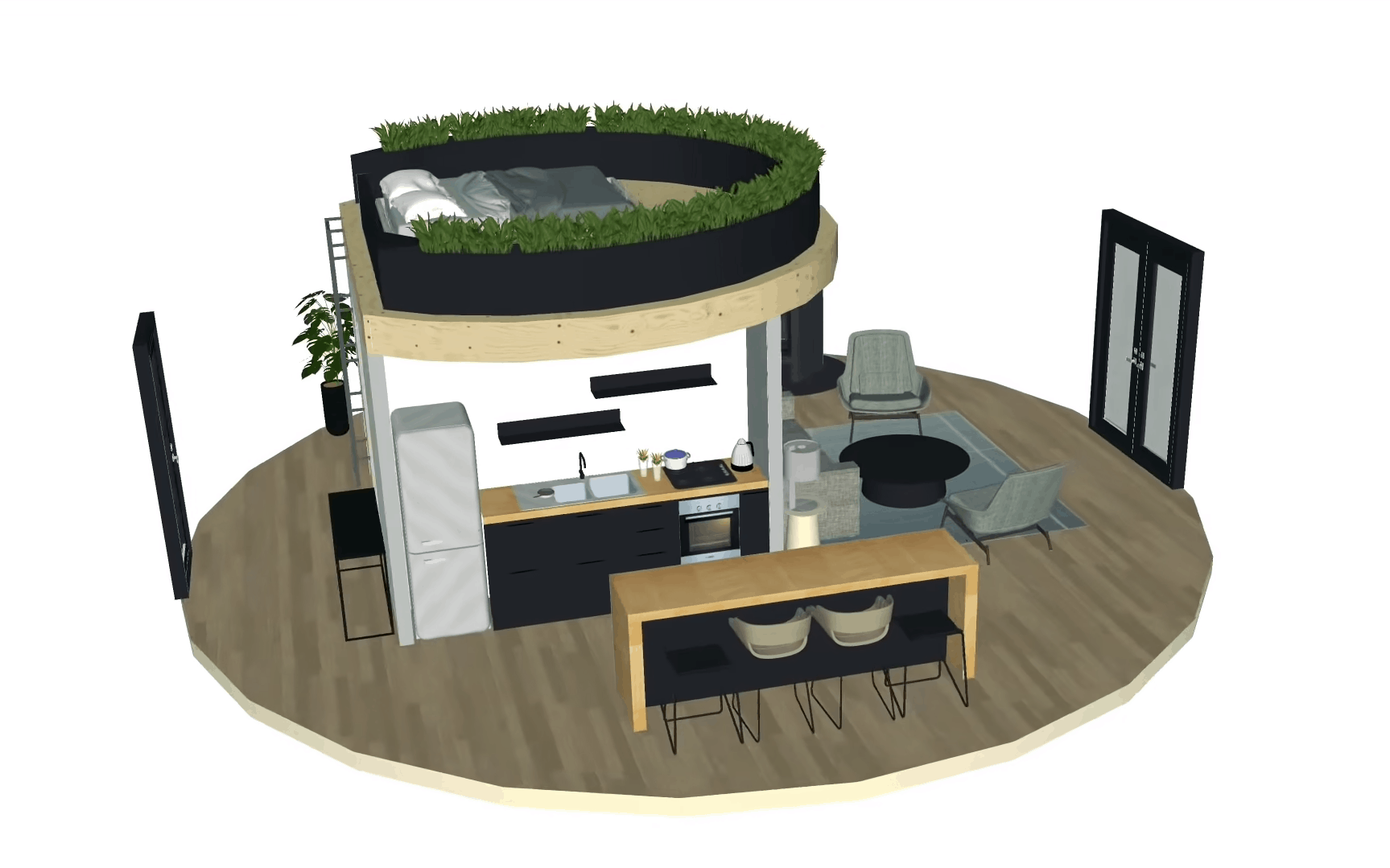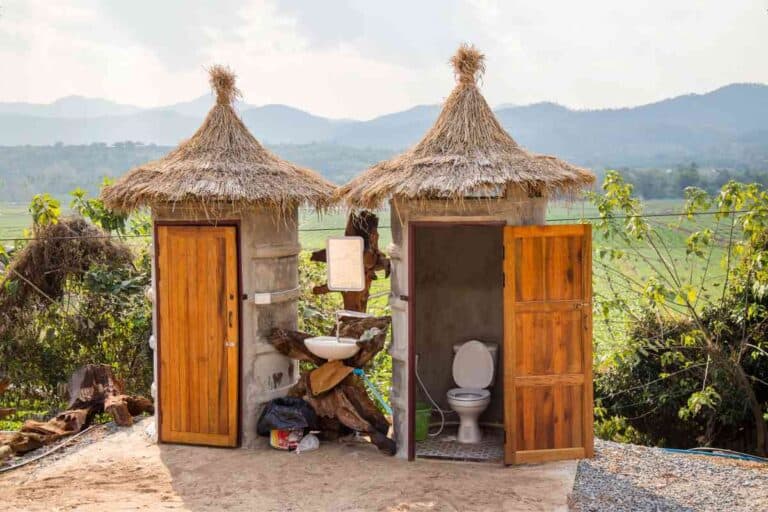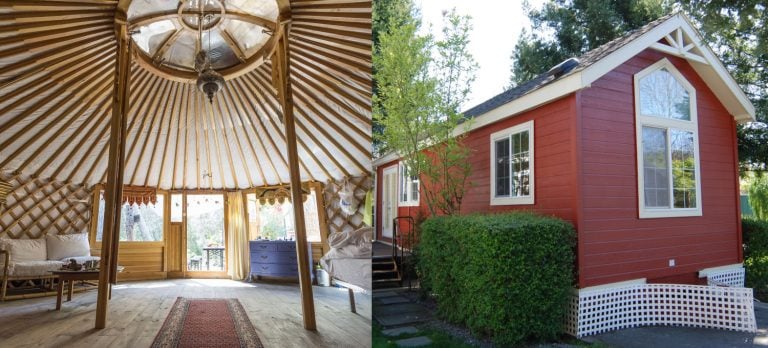Yurt Vs Cabin: Which Is Better?
Who wouldn’t want to have their own cabin away from home – particularly during these uncertain times? Maybe a full-time home in the woods, or perhaps just a place to wind down from time to time.
I’m guessing you are here because this is your dream, too, and perhaps you are planning to make that dream a reality. But is the ever-popular cabin the best option? Yurts seem to gain popularity, and for good reasons, so what is the better option? Essentially, there is no ‘best’ choice. IT all depends on your preferences:
Yurts are more affordable and much easier to build than cabins. Cabins are more solid and will and last longer with limited maintenance, but they also cost more.
Let’s go through the respective pros and cons of yurts and cabins. Hopefully, this will help you make an informed decision.
Price of a Yurt Vs Cabin
Yurts are very affordable in comparison to most other habitable structures. While price largely depends on the yurt’s size, several other factors also come into play, such as the quality of materials and where you buy them. And, of course, whether you set it up yourself or hire builders.
A smallish 15-foot yurt (177 sq. ft.) will cost anywhere from $4,000 to $20,000, while a larger 30-foot yurt (706 sq. ft.) typically costs from $20,000 to $40,000. You can generally get a large yurt of good quality with multiple additions for about $25,000 or approximately $35 per square foot.
In comparison, you can expect to pay about $20,000 for a basic 200 square foot log cabin kit, i.e., $100 per square foot. If you hire professional builders, total costs will be around $125 to $175 per square foot or about $105,000 for a 700 square foot cabin.
Add to that additional expenses such as connecting to the power grid and municipal utilities (if this is part of your plan) plus at least $5,000 for basic appliances and miscellaneous expenses. This cost of connecting to public utilities depends mostly on your location and should remain the same regardless of the type of building.
In short: Yurts are more affordable to build than cabins.
Does Size Matter?
Yurts have certain size limits size due to the materials and construction method. The world’s largest yurt is a 28.81 meter (94½ feet) diameter Mongolian ger. There are larger buildings imitating the yurt look, but they are technically not yurts as they are made from solid materials such as steel and fiberglass. Realistically, 30 feet (706 sq. ft.) is considered a large yurt, although some sellers do offer kits up to 50 feet (1,963 sq. ft.).
On the other hand, a cabin can get as big as you want. While cabins are generally seen as small-ish buildings, they can be practically any size you want and certainly much larger than yurts. If you dream of erecting a large home with multiple rooms, you may want to go for a cabin.
In short: Cabins can get bigger than yurts. Although, if you are planning a small to medium build, this makes no difference.
Which One Offers the Most Design Freedom?
Yurts are by definition round, meaning you will have to adapt your design to the curved outer walls.
This does not mean you can’t be creative. In fact, creativity is a nessecity when designing the interior of a yurt, and you will need to rethink some of the conventional design concepts which more suitable for standard square layouts of most homes.

You can take advantage of the high ceiling in the center, as shown above, or you can set up interior walls and divide your home into individual rooms, although most yurt owners do prefer the open space.
Cabins offer much more flexibility. It is relatively easy to build a second story, add extensions, etc. Generally speaking, square designs are easier to do when working with wood, but you could also build a circular cabin if you like the yurt look but prefer a more solid construction.
In short: Yurt designs are limited to a circular shape, whereas cabins can be build according to almost any design imaginable.
Ease of Build
There are good reasons to DIY your cabin or yurt. One reason is the pure joy of building your own home and living in it afterward. Another reason is the savings as labor makes up a significant chunk of the cost of constructing any type of home.
Yurts are very easy to build. They are essentially large, somewhat more complicated tents. No welding is required, and you only need minimal concrete and carpeting skills – mostly to build a solid deck foundation. Completing a yurt is a quick process that takes from just a few hours to one weekend, depending on the size and your experience.
Building a cabin requires more skills and a lot more work. It certainly is possible to build a cabin with little to a construction background, but you will need to spend a lot of time learning and making some mistakes. Building a log cabin takes around four to six weeks.
In short: Yurts are easier and faster to build than cabins.
Lifespan and Durability
As is almost always the case, durability depends on the maintenance and quality of materials. Therefore, it is not possible to make a clear-cut generalized comparison between yurts and cabins. However, the materials commonly used in each of these do give cabins the advantage.
The yurt exterior consists of a fabric cover, which is less durable than wood and other solid materials. Generally, a yurt needs significant maintenance done every 10 to 15 years, such as new covers and a new dome.
A well-made cabin, on the other hand, can last for decades with only basic maintenance. Eventually, the roof will need to be replaced, but this should not be needed for 30+ years. With the exception of the cheaper types of asphalt shingles which generally last about 20 years.
In short: Cabins last longer with minimal maintenance compared to yurts.
Zoning, Building Codes, and Permits
This highly depends on your location. In some locations, yurts are considered temporary structures – like tents. In other places, this depends on how the yurt is made. If in doubt, your best solution is to talk to your county clerk, who should be able to help you get acquainted with local regulations.
In many jurisdictions, a permanent structure is defined as having a foundation, meaning a yurt without a foundation is considered a temporary building (such as a tent). In which case you may not require a building permit. However, there are multiple practical reasons why you would want a foundation, including efficient insulation and protection against rodents.
One issue with yurts is that they are relatively uncommon and thus often difficult to get approved – at least without first going through a lot of red tape. Some authorities may even outright reject your application by referring to paragraphs in their zoning laws prohibiting tents or because they don’t know how to categorize a yurt.
Cabins, on the other hand, are well-known, and regulators will have taken them into considerations when defining building codes and zoning rules. These regulations can be complicated and demanding, but it is typically much easier to get the right information about how to legally build a cabin than a yurt.
In summary: Zoning, codes, and permits vary from state to state and from county to county. In some locations, yurts require less paperwork and fewer permissions, while in other locations, cabin building involves less red tape.
Should I get a Yurt or a Cabin?
The choice between a yurt and a cabin largely depends on your purpose and preferences:
- Advantages of yurts
- Affordable
- Easy to build
- Advantages of cabins
- More solid construction
- Longer lifespan
- More design freedom
Both yurts and cabins alike are great for vacations and full-time living. You can build them yourself with limited previous knowledge and on a budget. Both yurts and cabins are available as prefabricated kits. If you are hiring professional builders, expect to pay much more for your cabin as it takes a lot of labor to finish.



![Are Yurts Good For Hot Weather? [4 Tips To Stay Cool!]](https://freedomresidence.com/wp-content/uploads/2022/05/Can-You-Live-in-a-Yurt-Year-Round-2-768x512.jpg)


